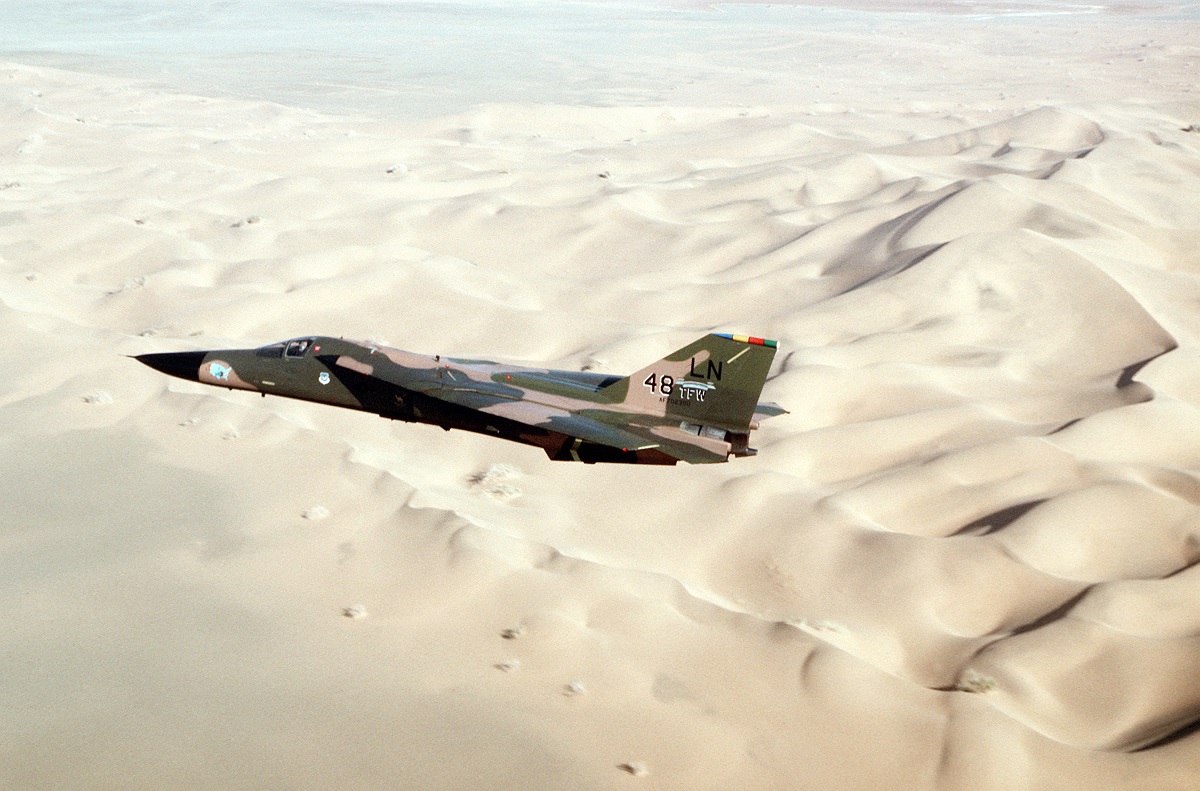The sixth aircraft on the Bab al-Aziza target, an F-111F 70-2389 with the callsign “Karma 52,” mysteriously disappeared
On April 14, 1986, at 5:13 p.m., President Ronald Reagan gave the order for U.S. Air Force (USAF) F-111F Aardvarks from the 48th Tactical Fighter Wing (TFW) to depart from Royal Air Force (RAF) Lakenheath.
Operation El Dorado Canyon, a code name for the operation, was carried out in retaliation for the terrorist bombing of the La Belle Discotheque in West Berlin on April 5, which left two American soldiers dead and more than 200 others injured.
All but one aircraft made it back to the base.
The sixth aircraft on the Bab al-Aziza target, an F-111F 70-2389 with the callsign “Karma 52,” mysteriously disappeared. The crews of multiple aircraft witnessed a fireball strike the sea in the harbor area, and many believed the F-111F had been struck by a missile, as stated by Peter E. Davies in his book F-111 & EF-111 Units in Combat. By the time the jet hit the water, the escape module housing the pilot, Capt. Fernando “Nando” Ribas-Dominicci and his WSO, Capt. Paul Lorence, had not yet deployed. The F-111 ‘Remit 31’ pilot saw the crash and said, “It was a smear across the water.” I was brought back to my experience of seeing napalm in Vietnam. Additionally, one of the EF-111As could see it:
“From our vantage point just off the coast of Tripoli, we saw F-111Fs pass under us as most of them had their afterburners as they ingressed at 550-600 knots. At the time Fernando went down, I saw what appeared to be a fireball skipping across the water on ingress.”
A few seconds later, “Karma 53” (F-111F 71-0889) noticed a flash and fireball immediately in front of them and thought it was an F-111 being struck by a SAM. After that, they had to make a quick turn to escape getting struck by a SAM themselves.
One of the tankers orbited in vain for “Karma 52” before returning home as dawn broke. By that evening, searches by P-3 patrol planes and a US Navy submarine had been suspended, and by April 17, it had been determined that the crew of “Karma 52” had been killed in action.

It’s possible that the ECM pond on “Karma 52” failed to protect them. Many of the then-AN/ALQ-131 ECM pods, which were installed beneath the aircraft’s rear fuselages for missile defense, had malfunctioned, according to post-mission inspections, as a result of the mission’s protracted beating from high-speed airflow. When the pods were later examined, components did indeed fall out of many of them.
Capt. Lorence’s final fate is unknown; only his helmet washed up on the shore. An autopsy performed after the pilot’s body was returned to the US via the Vatican in 1989 revealed that he had drowned while unconscious. Capt. Ribas-Dominicci was a member of Lakenheath’s elite Standardization and Evaluation unit, and the year before, when another F-111F experienced an undercarriage issue, burst a main-gear tire on landing, and ran off the runway, he narrowly escaped having to eject.
Some of their coworkers believed that the decision to expand the Bab al-Azizia element to nine aircraft may have had a role in “Karma 52’s” loss.
Lakenheath planners rather favored a six-aircraft strike on the relatively tiny Bab al-Azizia site, three against the training camp, and nine to bomb the somewhat bigger and more open Tripoli airport objectives.
The longer, more intense assault that was planned on Gaddafi’s compound would leave the aircraft vulnerable to its strong defenses for over four minutes. Despite Lt. Col. Pastusek and Col. Bob Venkus, vice-commander of the 48th TFW and an important player in the planning, objecting, Lakenheath’s wishes were rejected. To do as much damage to this obvious target as possible, the nine-aircraft attack on Bab al-Azizia was demanded. Attack strategies have to be quickly revised to prevent conflicts with the meticulously planned route developed with the US Navy. The strategy for refueling was also enlarged.
The initial plan’s deviation provided the Libyans with “a succession of single-file targets — ducks in a row,” as former 48th TFW WSO Maj. Jim Rotramel put it. At Lakenheath, anxiety levels spiked in response to this possibility. The risk to the final three-aircraft cell (‘Karma’) increased, but the likelihood of precise hits by aircraft flying after those that had successfully dropped bombs was significantly decreased.
To his great surprise, the Third Air Force commander, who was aware of the numbers issue but was unable to persuade his superiors to change their minds, informed the highly experienced Vietnam veteran “Karma leader” that it would be acceptable to abandon his attack if the defenses proved to be too effective. For the leader of “Karma,” this total reversal of standard USAF doctrine was shocking. The “Liberty Wing” had to follow the predetermined course of action despite being aware of its possibly catastrophic defects.
The names of Ribas-Dominicci and Lorence are inscribed on a plaque that is located today across from the 48th Medical Group hospital and honors the members of the 495th Tactical Fighter Squadron (TFS).

Photo by U.S. Air Force
F-111 & EF-111 Units in Combat is published by Osprey Publishing and is available to order here.

